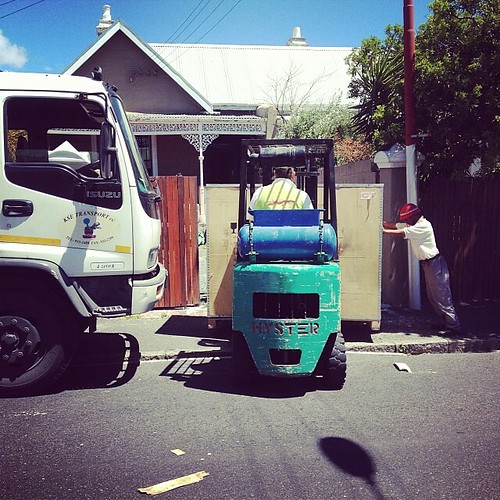As my system is 3 Phase, I thought I’d talk about some of the different 3 Phase standards for wiring.
3 Phase, as you may or may not know, is better for transmission of power.
Power stations generate electricity at 22 000 volts (3 phase 50Hz). To transmit this power over long distances, Eskom steps up the power to to the following voltages for transmission: 220kV; 275kV; 400kV or 765kV. This electricity now goes into our national grid.
When it gets to the end user it is stepped down. This could be 11kV for a large factory or 400V(380V) for shops/homes. If you take a phase to neutral (single phase voltage) i.e. 400V/sqrt(3) you will get 230V single phase @ 50Hz.
When it gets to the house, it generally gets split up into single phase, and different circuits get each phase. So, the lights might be on one phase, the plugs on another, and heavy equipment may use all three (eg an old 1950’s Oven dating back to the Union of South Africa!).
Plug sockets at home are single phase 230VAC 50Hz.
There are two main connection standards for 3 phase; Delta wiring – which uses 3 wires, and Y wiring (also known as wYe), which uses 4.
Delta has one wire for each phase so 3 wires total.
Y wiring has one wire for each phase, plus a neutral, for 4 wires.
In my house, we have 4 wires, so its the Y standard.
You can check this by looking at how many wires go from the house to the street.
In our case, this is 4 separate wires, as you can see below:

So, what exactly is 3 phase?
AC current runs in a sine wave. This sine wave runs at 50hz for South Africa (50 ups and downs a second). In 3 phase, each phase is run at an offset of 120 degrees, so each phase peaks at an offset of the other. The 3 phases add up to a total of 380v – although these days is more likely to be closer to 400v, as the rest of the world has migrated to that. Either makes no difference, as they’re both values within the margin of error for provision of electricity.
Its extremely important to know what you have with regards to wiring, as it involves large amp circuits, and you don’t want to wire things incorrectly and cause Eskom to come smack you for tripping the street transformer!
Three phase is relatively easy to turn back into 1 phase – I’ll be doing that on one leg to provide an additional “solar” circuit for our laundry room.
Those of you who like the technical aspects should take a look here –
http://ece.k-state.edu/~starret/581/3phase.html
Some basic calculations for 3 phase below. These can be used to work out your maximum load or other important wiring details, like how thick your electrical wire should be if you’re carrying whatever max current your supply provides…
Basic electrical calculation:
Volts = Watt ÷ Amps
Volts = Ampere x Ohms
Amps = Volts ÷ Ohms
Amps = Watt ÷ Volts
Ohms = Volts ÷ Amps
Volt-Ampere (VA or Watt) = Volts x Ampere
For 3 phase, we need to use the square root of 3 for our calculations as an additional factor.
The square root of 3 is 1.73 (rounded off to 2 digits).
So, to calculate VA its: Volts x Ampere x 1.73
Example calc:
KVA = (Volts x Ampere x 1.73) ÷ 1000
= (400 volts x 60 amps x 1.73) ÷ 1000
= 41520 ÷ 1000
= 41.52 KVA
We can also work out the Amps as below:
KVA = (Volts x Ampere x 1.73) ÷ 1000
41.52 KVA = (400 volts x A x 1.73) ÷ 1000
41.52 x 1000 = 400 x A x 1.73
41520 ÷ (400 x 1.73) = Amps
41520 ÷ 692 = 60 Amps
If we wanted to convert KVA to KW, we need to use a power factor (this represents losses in transmission). The figure used for this is typically 0.85, so
KW ÷ 0.85 = KVA
KVA x 0.85 = KW
Simple!
A more detailed explanation of power factor losses is here – http://www.energyaction.com.au/australian-energy-market/power-factor.html
![]()
